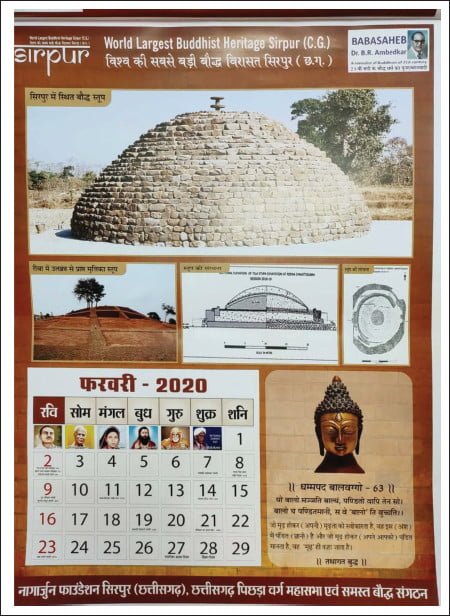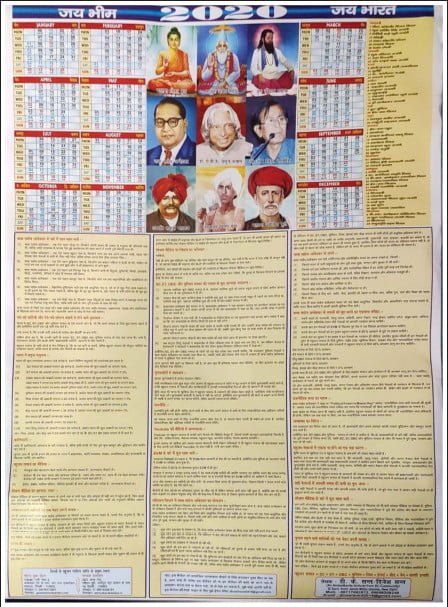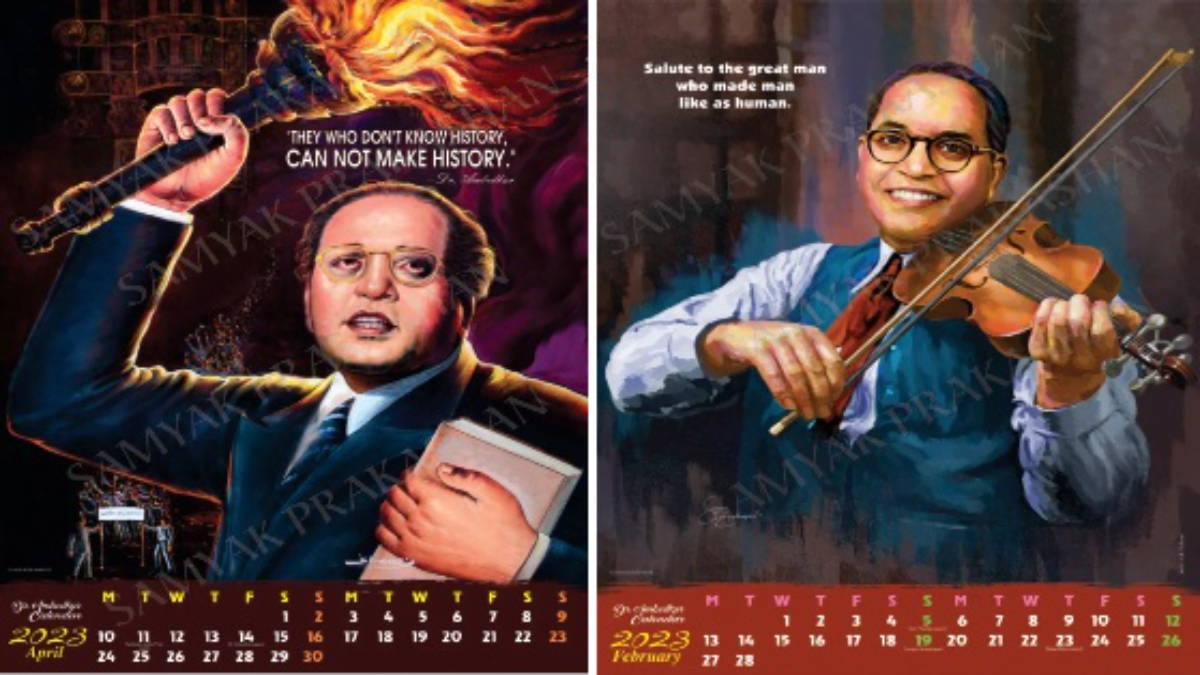New years come with lots of things in our lives, from emotional to material ones. One such thing is buying a calendar. As the new digital age has arrived, people access calendars in their digital devices. But still most people prefer to have calendars in the physical form on their desks or on the walls of the houses. But this is not used solely for seeing the dates and making plans accordingly. When I was a child, on the early morning of the new year, with the Hindi newspaper, my family used to receive a calendar. Dates with the holidays, horoscope, Hindu gods and prayers were imprinted on it.
These calendars had images of bahujan activists with their quotes, birth anniversaries, death anniversaries and special days of bahujan history.
But my uncle used to give us another calendar full of photos of Savitribai Phule, Dr. Ambedkar etc. These calendars had images of bahujan activists with their quotes, birth anniversaries, death anniversaries and special days of bahujan history.
What is calendar art?
Calendar art is a print form that is circulated widely and its iconography represents local forms of community iconography and values. Calendars are cultural artifacts through which mass culture and everyday life are displayed. ‘The iconography of calendar art not only reflects the aesthetics of the community, but also underlines how the visual arts inscribed within calendars have been a way of reimagining identities’ according to Jain and Uberoi.
Calendars: a symbol of one’s beliefs
The calendar hung on the walls of homes, which is also called Tithipatra or Dindarshika in Hindi, is a neglected heritage of visual culture. In a common person’s house, one can definitely see a calendar in the living room on which pictures of some Hindu deity or other things can be seen. On some calendars one can see Nanak, Jesus, verses from the Quran, etc., and the months are written below the picture. This visual representation shows which community one may belong to, what their beliefs are, and how they spend their days. For example, in many homes, fasting is observed on certain days.

These religious/cultural activities and their dates differ from community to community. This visual culture creates a stronger bond between people based on their mutual values, ideas, and the things and people they believe in. In the second half of the nineteenth century, a printing industry entirely devoted to the production of pictures of gods, goddesses, and mythological themes emerged in India. By the end of the century, these cheap mass-produced pictures became the most influential medium of visual communication of the then socially and culturally fragmented Indian society.
In these pictures of god’s, mostly Hindu male gods are seen, with a few female gods which can be seen as the socio-cultural milieu of the time telling us who must be the head of a family or society. On the other hand, bahujan calendar art is totally different from it. This art symbolises equality, struggle and power to overcome the sufferings.
What is bahujan calendar art?
Revolution and counter-revolution in ancient India is a text by Dr. Ambedkar in which he conveys to the readers the rise of Buddhism as a revolution, and how the Brahmins in India dealt with it. Ambedkar considers this Buddhist intervention to be the counter-revolution which can lead to the eventual downfall of Brahmanism in India. Hence, what is coming as a counter-attack to the upper caste’s culture via any medium from bahujans is counter culture. Bahujan Calendar art is such a medium of counter culture.
Popularity of the bahujan calendar
The idea of such art forms started taking shape in North India in the 1990s when the charismatic Bahujan leader and the founder of Bahujan Samaj Party, Manyavar Kanshiram ignited the anti caste awareness movement at political, cultural and ideological fronts. It finally came into its existence at mass level when in 2014 BSP supremo and former Chief Minister of Uttar Pradesh, Behanji Mayawati launched the first Bahujan Calendar in Savdhan Vishal Maha Rally in 2014 on her birthday. In the same year, Prof. Ramvilas Bharti of Bahujan Kalyan Parishad launched another bahujan Calendar in which the calendar starts with 14th April, the birthdate of Dr. Ambedkar.

K.Kalyani writes, ‘The Calendar art has engaged with a reiteration of anti-caste social icons that has generated a visual effect on the collective memory of the community.’ Calendars have been the cheapest medium through which knowledge through images and iconography reaches to the people. The images of Dr. Ambedkar, Savitribai Phule, Periyar etc reached the masses with their quotes which inspires the spirit of a person. The special occasions such as Buddha Jayanti, Ravidas Jayanti were introduced to people.
While savarna calendars filled with horoscope, fasting dates might encourage people to practice superstitions, bahujan calendars inspire people to hone a scientific temperament.
In the calendar images, the bahujan personalities are smiling or have neutral expressions depicting hope that education can change the situation of bahujans. While savarna calendars filled with horoscope, fasting dates might encourage people to practice superstitions, bahujan calendars inspire people to hone a scientific temperament. Calendars have a reiterative flow of images and themes that reflect culture and community ethics. The symbolic meaning of the icons has emancipatory meanings for the Dalit–bahujan community in particular according to research by Ciotti, Jaoul, Tartakov, Thorat and Zelliot.
Bahujan calendar art also acts to preserve bahujan culture and navayana buddhism. The panchsheel flag, peepal tree and images of Saint Ravidas and Saint Ghasidas can be seen in calendars. Inclusion of all the anti caste leaders from India, conveys the message to bahujans that they are all one as they have some common past. This ignites the emotion of oneness among marginalised sections of this nation which is very necessary to de-brahmanise the culture and lead an anti caste consciousness.
Creativity prospering through bahujan calendar
There are many uses of having a Bahujan Calendar, especially for those Dalit-bahujans who cannot know about the bahujan liberators from very expensive books. The pictures and thoughts of bahujan humans have reached such people in the printed form only because of these calendars.

Removing Hindu gods and goddesses from the homes of Dalits, bahujan heroes have been celebrated through this art. Because calendar art also has a place for imagination, it has also created such images of bahujan heroes which are difficult to see in the mainstream, such as the presence of Baba Saheb in the picture of Buddha, Dr. Ambedkar encircled with children, and depiction of Navayana Buddhism.
Bahujan calendar cultivating anti-caste awareness
Visual culture and the act of seeing and what is seen, also determine the social relationship of who has authority according to Berger and Mirzoeff. This sense of authority that bahujan nayaks (bahujan leaders) are holding is the essence of anti caste awareness. It can be said that their invisible presence have led the movements whether it was the protests after Rohith Vemula’s death or any other protests that happened during atrocities on Dalits.
Bahujan calendar art rejects the authority of the Vedas, and of Hindu scriptures, depicted on savarna calendars which in the name of ‘national culture’ promote Hindu culture only. Bahujan calendar art has given the people a newer perspective to see that a year can be accessed through bahujan lens where days hold different significance than they do to savarnas.
Bahujan calendar art has given the people a newer perspective to see that a year can be accessed through bahujan lens where days hold different significance than they do to savarnas.
From 2014, bahujan calendars from several publications are being sold every year, from Samyak Prakashan to Dalit Dastak. This art form is challenging the so called mainstream narrative of savarnas and making space for bahujans in printing art where they can print their history in the form of images and reach the marginalised masses to make them aware about the cause, liberation and liberators of bahujans.




